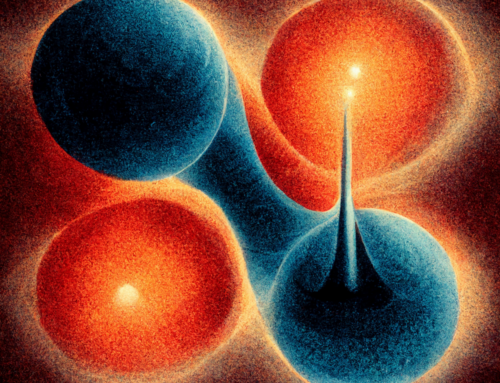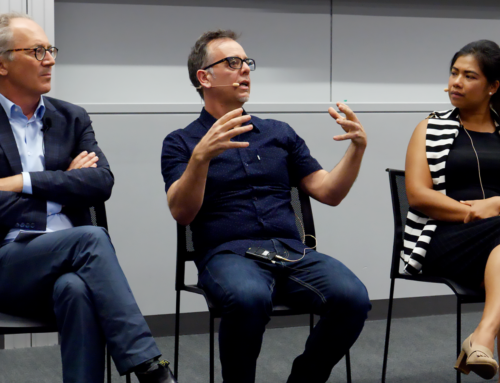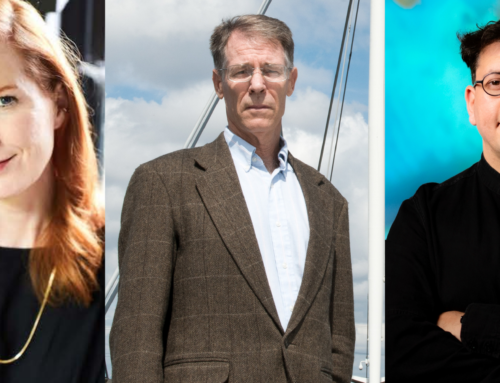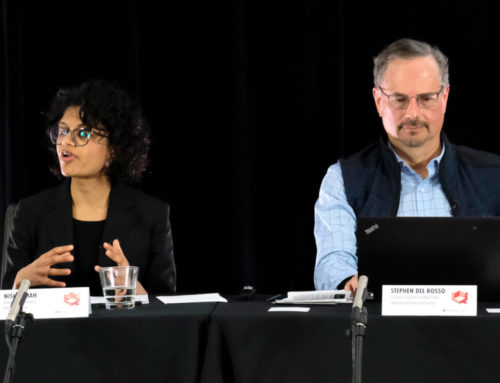Saturday morning’s panel on “Time: Historical, Representational, and Relative” continued Q’s experiments with the entanglements of the physical and social sciences with theory and aesthetics. In his introduction of the panel, Jairus Grove (Assistant Professor of Political Science at the University of Hawai’i-Mānoa) noted that his charge included Particle Fever director Mark Levinson and University of Florida political science Professor Badredine Arfi, two trained physicists who had moved on to other endeavors but never left the field behind them. The panel’s third presenter, Professor Dean Rickles, specializes in quantum gravity and string theory and is now Professor of History and Philosophy of Modern Physics at the University of Sydney. Simon Reay Atkinson, whose career has taken him from aircraft carrier to college quad as a professor, engineer, and Captain in the Royal Australian Navy, rounded out the panel’s eclectic ensemble in his role as discussant.
Mark Levinson began with reflections on his time in physics and film and a story of eternal return. Thanks to the internet (and its shortcomings) and the publicity that follows a well-regarded documentary, Levinson always gets two questions. Many people ask him what it’s like to have been married to Kim Cattrall, with a misleading Wikipedia entry leading people to mistake him for Cattrall’s eponymous ex-husband.

Mark Levinson discusses time in early filmmaking as co-panelist Dean Rickles and moderator Jairus Grove look on. (Photo: Gilbert Bel-Bachir)
Everyone else asks how it is to “leave” physics for filmmaking. Levinson’s answers that he never really left theoretical physics– he just became “a very, very theoretical physicist”. For him, the two professions aren’t so different from one another. The labor of physics begins with writing theory. In film, one writes a script. These then provide the framework for actualization through experimentation and shooting, respectively. The products are then taken up by theorists and editors, who sift, synthesize, and structure the raw outputs of data and footage to determine its meaning. Both science and art, he continued, search for symbolic representations of the universe that despite conciseness or reduction – or perhaps because of it– can reveal depth and truth. In this film, exists on a continuum of symbolic representation that began with the aboriginal cave paintings mentioned by Matthew Doyle and the paintings in Chauvet Cave featured in Werner Herzog’s Cave of Forgotten Dreams.
https://www.youtube.com/watch?v=RcAwlnhRn2g
The earliest films captured simple happenings, and early narratives were essentially plays filmed for posterity and re-production. In both the camera provided the viewer with a presence elsewhere, be it a Chinese curb or a front row seat in an imaginary theater.
https://www.youtube.com/watch?v=xpxlZrEnPz4
But the development of film as both technology and practice came at a critical juncture, amidst the veritable revolution in cultural and scientific thinking about space and time touched on earlier by fellow Q presenters Arthur I. Miller and Stephen Kern. Directors like the notorious but technically virtuosic DW Griffith developed new techniques like parallel editing (or crosscutting) to play with time and space, elision, and simultaneity that left behind the stationary “preferred observer” to move through time and space in the service of a more compelling narrative. Rather than putting a viewer in the place of a stationary observer at Ford’s Theater, directors like Griffith could cut to different vantages and characters to provide a more complete (and compelling) depiction of Lincoln’s assassination in Birth of a Nation.
Like similar developments in literature and visual art, these techniques were widely adapted and became massively successful with audiences. Physics has faced a tougher crowd, but Levinson wondered if perhaps humanity will find a new method of representation that can provide the same type of quantic and spatial leap to our understandings that film did. Which raised for him a question: is the ultimate goal of both science and art the transcendence of time and space?
Beginning with general relativity, science has already problematized our intuitive sense of time. The panel’s next presenter, Dean Rickles, acknowledged as much in a video interview for the American PBS series Closer to Truth which asked, “Is time fundamental?”
http://www.closertotruth.com/series/time-fundamental#video-3794
Beginning his talk, Rickles acknowledged that his presentation would be “the weirdest talk he’d ever given– which was saying something.” He had felt at first that the Q Symposium lent itself to a “mangling of concepts that don’t belong together.” Nonetheless, his talk on “War at a Distance” spoke to the impact of the First World War on mathematics and vice versa, a war in which non-locality and the harnessing of physical laws led to new developments in both warfighting and mathematics.
From the shelling of Fort Sumter to Hellfires in Afghanistan launched from drones being piloted in a trailer in Nevada, the use of mathematics of ballistics and targeting algorithms has increased the distance between shooter and target. This distance becomes as cognitive as well as physical, akin to modes of thinking that enabled people to tolerate extreme poverty, the vicissitudes of financial trade, and internet bullying. The distancing technology and technē of modern war requires an approach in which war becomes a technical problem to be solved through mastery of physical laws and mathematics. Paired with inclinations towards symmetry and pattern seeking, scientific wars became increasingly catastrophic over the course of the 20th century.
World War I provided ample evidence for this observation. Jeanne Alexander, a French woman and staunch pacifist despite her brother’s involvement in the French industrial mobilization efforts, observed “Our true adversaries in today’s war are mathematics professors at their tables, physicians and chemists at their laboratories. War at a distance, war of industry.” The war proved a true adversary to scores of young mathematicians, particularly the French whose republican notions of shared sacrifice led some to conclude that the war had been particularly disastrous for a generation of young scientists and mathematicians who were not spared from seeing the front.
With the war killing over 50% of the immediate pre-war classes of France’s prestigious Ècole normale supèrieure and inducing a worldwide slowdown in publications, the view of the war as a significant disruption to mathematics is inarguable. There exists a French counterpart to the Forman thesis, which argued that popular discontent with Germany’s defeat helped push Weimar physicists to spurn causality and develop ideas that would help provide the basis for the quantum turn. The so-called Bourbaki thesis, named for the collective of innovative French mathematicians who rose to prominence during the inter-war years, was put forth by members of the collective themselves who attributed their positions to the loss of a generation of French mathematicians in the war.

Dean Rickles presents his talk, “Warring-at-a-distance: Mathematicians and the Moral Argument” as co-panelist Badredine Arfi listens.
(Photo: Gilbert Bel-Bachir)
On the eve of war, Andre Beaunier characterized the lofty intellectualism of French mathematicians thusly: “Such minds are located outside of time and space. They live and work under the auspices of eternity. Because of that, they are not easily intelligible.” But as the war brought French mathematicians back to the muddy, blood-stained earth, the post-war era led to a critical reevaluation of the traditional detachment of classical science. The post-war popularity of Oswald Spengler’s Decline of the West (focused on extensively by Forman in his thesis on Weimar culture and causality) epitomizes the reaction to these pre-war views and the experience of “mathematical war”, criticizing physics as having “nothing whatever to do with time” and privileging instead a “web of cause and effect… of timeless duration” at the expense of human experience in which “time is intensely personal, we ourselves are time.” This war-induced shift led Rickles to wonder what might have happened if a mathematically oriented moral argument had come before the war?
The panel’s last presenter was uniquely qualified to comment, as Badredine Arfi holds a PhD in both physics and political science. Training first as a physicist, he explained that the allure of philosophy and social theory proved irresistible temptations to pursue knowledge at different levels of thinking. In thinking differently about quantum and security, Arfi focused his presentation on what it means to speak of the ‘quantum’ in thinking about war, diplomacy, and international security and the implications of doing so.
Looking over the academic field, Arfi observed that those seeking to make sense of international security stumble over numerous paradoxes, contradictions, and inconsistencies. The time and effort spent trying to reduce and reconcile these discrepancies constitutes an essential component of what counts as contemporary scholarship. But what if we were to raise a serious question about the conventional wisdom requiring logical consistency? What if instead we were to contextualize and make explicit our dependence on the certain underlying logics of our respective theories?
Such a turn, Arfi figures, would require understanding the axiomatic assumptions that accompany our logic. As evidenced by his work on fuzzy logic, Arfi explained that the field of logic(s) itself is a growing and diversifying field with no expectation of integration on the horizon and that debates rage on within different types of logic.
If we are looking to translate quantum logic for the social sciences, then considering weird logic is a necessity. Arfi brought up a 2013 paper by Newton da Costa and Christian de Ronde on quantum superposition that makes contradiction a central component of its theory to illustrate his case. Does translating the quantum for social science require admitting laws that require contradiction?
Such an approach, Arfi warned, is shortsighted – even if social scientists seek to only claim the quantum metaphorically. Metaphors are never neutral and social scientists addressing the quantum need to determine whether they deal with the quantum as metaphor or as an original question of phenomena. But even those working in metaphor must make an assumption as to the translatability of realms of knowledge, performatively presupposing that language is objective enough for for clear translation. This, argued Arfi, essentially assumes a unity of science and knowledge which, if anything, is largely lacking in human history.

University of Florida Professor Badredine Arfi on “Inheriting from and Translating Quantum Logic(s) in (Re)Presenting Politics and Security”.
(Photo: Gilbert Bel-Bachir)
When drawing on the quantum beyond physics, these problems of metaphor and translation are serious. Not only does quantum have its own genre of thinking about the theories it addresses, but – as Chris Fuchs’s talk alluded to- it has its own ontological questioning. Arfi highlighted the difficulties in reconciling quantum theory and general relativity over the problem of time, which becomes largely a question of metaphysical attachments.
Time is as much a problem for philosophers (and artists) as it is for physicists. While usually taken for granted, human beings tend to experience time as a conjoined sequence of consecutive past/present/future. Like Proust, we struggle to find the time to experience even an instantaneous moment of time, finding instead that we can only watch it recede into the past or anticipate its future occurrence. What we experience as time is the trace of a past now or a future now yet to be experienced, the “actual” now can be registered as such only after it has already passed.
If our experience of time is disjointed and one cannot pin down any moment of time, is it possible to be auto-present? If identity– unable to experience itself as present– is never identical to itself, then the Aristotelian law of identity is broken. And just how secure is a being that experiences disjointed time in a world of contradiction and non-identity?
From this conclusion, Arfi posed new questions. How do we think about and address such a world? What kind of ethical responsibility is entailed? Can we reconstruct the phantasms of universal logic or must we get outside the Newtonian/Kantian worldview? Do we need thinking of security that pays close attention to the performative power of the ghost of logic and not logic itself? And if ours is a world of contradiction, non-identity, and disjointed time, what becomes of causality?
The vast scope of inquiry of the panel’s three presentations showed just how difficult it is to conceptualize time, regardless of its fundamental role in our experience and existence. Considerations of the problem of time in physics and philosophy are noticeably absent in security studies, where we can still treat Thucydides as a timeless foundation on which to build our focus on future threats. But as Q and its subject matter recedes into the past, we may have also caught glimpses of the futures of the field.
The image at the top of the post is a still taken from Safety Last (1923).







[…] apart in the universe that the photons they emit will never reach each other. Saturday morning saw Badredine Arfi problematize the notion of a discernable present and question the stability of identities that cannot be auto-present. In both the physical or […]